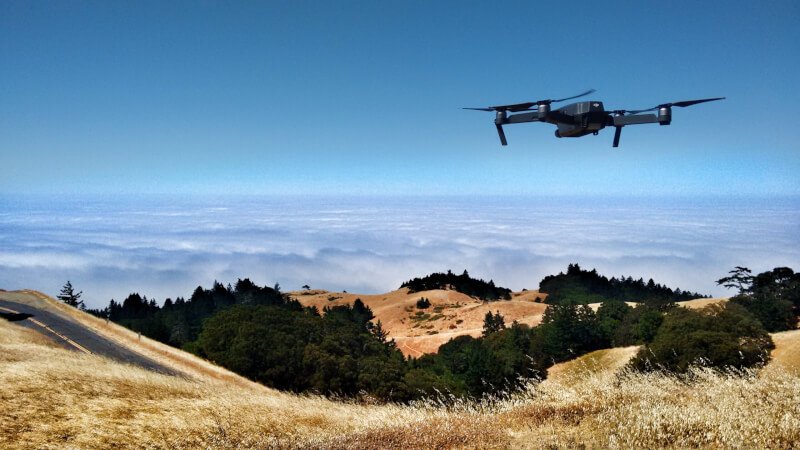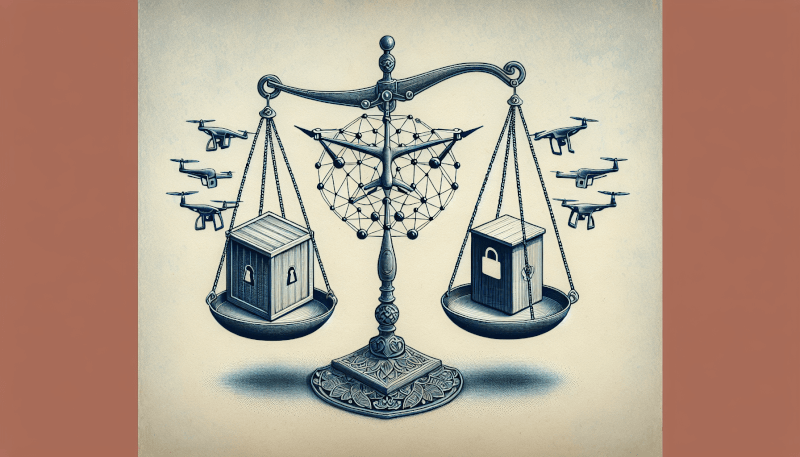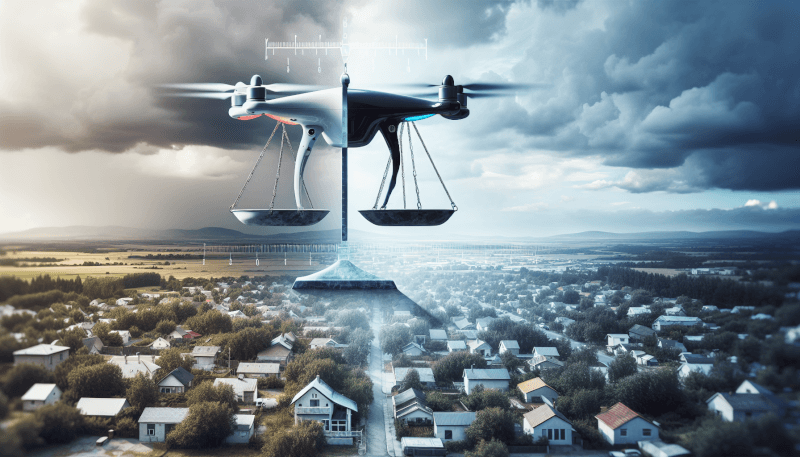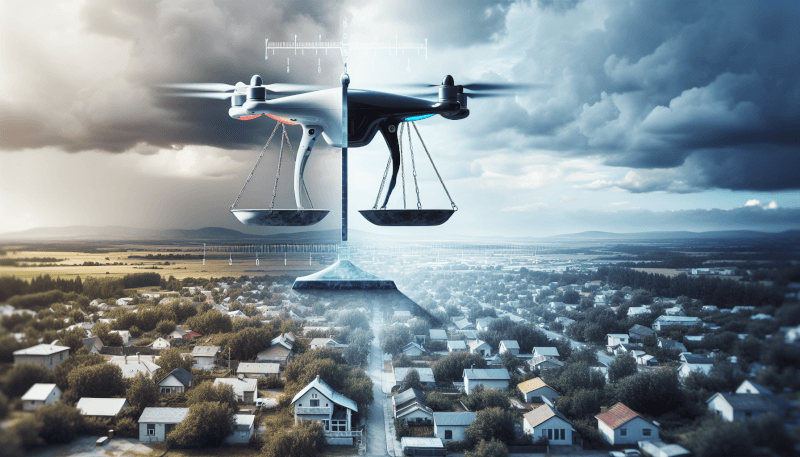In the world of technology, drone surveillance has emerged as a powerful tool for monitoring and securing public spaces. However, this advancement has sparked an ongoing debate about the delicate balance between privacy and security. While the use of drones can enhance public safety, concerns are raised about the potential invasion of privacy. This article explores the complexities of drone surveillance, analyzing the need to strike a harmonious equilibrium between safeguarding our communities and respecting individuals’ right to privacy. Stay tuned to discover how this evolving technology is shaping the future of surveillance practices.

The Rise of Drone Surveillance
History of drone technology
Drone technology has rapidly evolved over the past few decades, transforming the way we approach surveillance. Initially developed for military purposes, drones were primarily used for gathering intelligence and conducting reconnaissance missions. However, as technology advanced and became more accessible, drones began to be utilized in various industries, including agriculture, filmmaking, and even delivery services. This expansion of drone usage has also opened doors for their application in surveillance.
Advances in drone capability
The capabilities of drones have escalated dramatically. Today’s drones are equipped with high-resolution cameras, infrared sensors, and even thermal imaging technology. These advancements allow drones to capture precise details from a distance, enabling effective surveillance in both day and night conditions. Additionally, drones can now fly for longer periods, covering larger areas and improving their overall surveillance potential.
Increased use of drones for surveillance
The widespread availability and affordability of drones have led to an increase in their use for surveillance purposes. Law enforcement agencies, private security firms, and even individuals are embracing drone technology to enhance their monitoring capabilities. Drones are particularly valuable in situations where traditional surveillance methods are limited, such as in rugged terrain or during emergencies. With the ability to access areas that are otherwise difficult to reach, drones offer a new perspective on surveillance.
Privacy Concerns
Invasion of privacy
While drone surveillance undoubtedly brings numerous benefits, there are valid concerns about the invasion of privacy. Drones equipped with high-definition cameras can capture detailed images and videos, raising questions about an individual’s right to privacy. Whether it is monitoring activities within private property or capturing personal moments unknowingly, the potential for invasion of privacy is a significant concern.
Potential for misuse
The growing accessibility of drones also raises concerns about their potential for misuse. In the wrong hands, drones can be used for illicit activities, including stalking, harassment, and even corporate espionage. The ability to hover undetected and gather information from a distance presents significant risks if proper safeguards and regulations are not in place.
Lack of consent and notification
One of the primary concerns regarding drone surveillance is the lack of consent and notification to individuals being monitored. Unlike traditional surveillance methods, drones can operate discreetly without individuals’ knowledge, leaving them unaware that their actions are being observed. This lack of transparency can lead to feelings of unease and violation of privacy.

Legal and Ethical Considerations
Existing laws and regulations
As the use of drones for surveillance has become more prevalent, governments around the world have implemented laws and regulations to govern their usage. These regulations vary by country, but they generally address issues such as flight restrictions, pilot licensing, and privacy concerns. However, keeping up with the rapidly evolving drone technology and adapting legal frameworks accordingly remains a challenge.
Privacy rights and protections
Privacy rights play a crucial role in the discussion surrounding drone surveillance. Balancing the need for security and public safety with individual privacy is a complex task. Striking the right balance requires carefully crafted legislation that ensures privacy protections while still enabling the effective use of drones for surveillance purposes.
Surveillance guidelines and restrictions
To mitigate the potential privacy concerns, many governing bodies have implemented surveillance guidelines and restrictions for drone operators. These guidelines may include limitations on flight altitudes and distances from people’s residences, ensuring that the surveillance is conducted in a manner that respects privacy rights. Moreover, adherence to these guidelines can help promote responsible drone usage and prevent abuses of surveillance capabilities.
Benefits of Drone Surveillance
Enhanced security and crime prevention
Perhaps the most significant advantage of drone surveillance is the enhanced security it provides. Drones can efficiently monitor large areas, detecting suspicious activities, and promptly alerting authorities. Their aerial vantage point allows them to access hard-to-reach locations, providing valuable insights into potential security breaches. By acting as a deterrent and assisting in crime prevention, drones contribute to safer communities.
Efficient monitoring of large areas
In scenarios where monitoring large areas is essential, drones offer exceptional efficiency. For instance, in monitoring border regions, drones can cover vast stretches of land efficiently and cost-effectively. This capability reduces the need for a significant human presence, enabling resources to be allocated more effectively.
Disaster response and search operations
Drones are invaluable in disaster response and search operations. In natural disasters or emergency situations, drones provide rapid, real-time information to first responders and aid in making critical decisions. Equipped with thermal imaging or multispectral cameras, drones can locate survivors, assess structural damage, and identify potential hazards, ultimately saving lives and expediting rescue efforts.

Technological Solutions
Geofencing and no-fly zones
Geofencing technology enables the establishment of virtual boundaries that restrict the movement of drones into prohibited areas. By implementing geofencing technology and creating no-fly zones, authorities can ensure that drones do not encroach upon sensitive locations such as airports, military installations, or private properties. This technological solution helps mitigate potential safety and privacy risks associated with drone surveillance.
Data anonymization and encryption
To address concerns regarding data privacy, drone surveillance operations can employ data anonymization and encryption techniques. By anonymizing personally identifiable information collected by drones, individuals’ privacy is safeguarded, and the risk of data misuse is minimized. Furthermore, encrypting the data ensures its confidentiality, preventing unauthorized access.
Audio and visual redaction
Audio and visual redaction technologies can be used to protect sensitive information captured by drones. By automatically blurring or masking parts of images or videos that may reveal personal details or compromising information, the risk of infringing upon individuals’ privacy is significantly mitigated. This tech-savvy approach strikes a balance between surveillance objectives and privacy concerns.
Public Opinion and Stakeholder Perspectives
Concerns from civil liberties organizations
Civil liberties organizations have expressed concerns about the potential risks associated with drone surveillance. These organizations advocate for strict regulations to protect individual privacy rights and ensure transparency in the usage of drone technology. By scrutinizing the potential drawbacks of drone surveillance, civil liberties organizations play a crucial role in fostering responsible implementation and usage.
Industry and government viewpoints
While balancing privacy and security, both the industry and government recognize the potential benefits of drone surveillance. The industry sees a significant market opportunity for drone technology, developing innovative solutions to address privacy concerns and improve surveillance capabilities. Governments, on the other hand, strive to strike a delicate balance between security needs and public interests, often working in collaboration with industry stakeholders to develop comprehensive guidelines.
Public perception and acceptance
Public perception of drone surveillance varies widely. Some individuals welcome the use of drones for increased security, while others express concerns about infringements upon their privacy. Educating the public about the benefits and limitations of drone surveillance, along with transparency in implementation, can help build trust and foster acceptance of this technology.

International Perspectives on Drone Surveillance
Comparison of surveillance practices around the world
Surveillance practices around the world differ significantly, influenced by cultural, legal, and historical factors. While some countries have embraced drone surveillance extensively, others have taken a cautious approach due to privacy concerns. Understanding these international perspectives provides valuable insights into the challenges and possible solutions for balancing privacy and security.
Differences in privacy laws and regulations
Privacy laws and regulations differ across countries, impacting the extent to which drone surveillance is permitted. Some nations have comprehensive frameworks in place, explicitly addressing privacy concerns related to drones, while others have yet to catch up with the rapid advancements in technology. Harmonizing privacy laws and regulations on a global scale is essential to ensure consistent protection of individuals’ privacy rights.
Global efforts to address the challenges
Recognizing the need for international collaboration, various organizations, including the United Nations and the International Civil Aviation Organization, are actively working to address the challenges posed by drone surveillance. These efforts aim to establish standards and guidelines that balance privacy and security concerns while fostering innovation and responsible drone usage on a global scale.
Drone Surveillance in Law Enforcement
Police and law enforcement use cases
Law enforcement agencies have found numerous use cases for drone surveillance. Drones can provide aerial support during criminal investigations, assist in traffic management, and help locate missing persons. Furthermore, drones equipped with facial recognition technology can aid in identifying suspects and enhancing public safety.
Legal limits and requirements
While law enforcement agencies benefit from drone surveillance, they are also subject to legal limits and requirements. Privacy laws dictate the usage of drones and restrictions on monitoring individuals without reasonable suspicion or probable cause. Additionally, law enforcement agencies must adhere to reporting and accountability measures to ensure their surveillance activities are conducted lawfully.
Community engagement and transparency
Building trust and fostering community engagement is crucial for law enforcement agencies utilizing drone surveillance. Proactive communication, public consultations, and providing transparency about the purpose, scope, and limitations of drone surveillance operations can help ease concerns and ensure that communities are active participants in shaping the use of this technology in their neighborhoods.

Oversight and Accountability
Government agencies responsible for oversight
To ensure oversight and accountability, government agencies play a pivotal role in regulating drone surveillance. These agencies establish and enforce regulations governing the usage of drones, monitor compliance, and conduct audits as necessary. Regular reviews and assessment of drone surveillance practices enable the identification of potential issues and the development of appropriate mitigating measures.
Review processes and audits
Continuous review processes and audits are fundamental to maintaining accountability in drone surveillance. Evaluating the use of drones, assessing their impact on privacy, and addressing any concerns or violations promptly are critical aspects of these review processes. Regular audits contribute to maintaining public trust and ensuring adherence to established guidelines.
Enforcement of regulations
Effective enforcement of regulations is essential in upholding the balance between privacy and security. Government agencies must actively monitor compliance, investigate reported violations, and apply appropriate penalties or corrective measures. Rigorous enforcement demonstrates the commitment to protecting privacy and deters abuses of drone surveillance capabilities.
Future Implications
Emerging technologies and their impact
The future of drone surveillance is closely tied to the rapid advancement of technology. Emerging technologies like artificial intelligence, machine learning, and automation are likely to play a crucial role in further enhancing the capabilities of drones. These technological advancements will undoubtedly present opportunities for improving surveillance effectiveness but will also require careful consideration of their impact on privacy and security.
Predictions for the future of drone surveillance
As drone technology continues to evolve, the future of drone surveillance holds promise and challenges. It is likely that drones will become more integrated into our daily lives, providing valuable services such as delivery, inspections, and monitoring. However, ensuring responsible usage and addressing evolving privacy concerns will be paramount to maintaining public trust and acceptance.
Balancing privacy and security in the digital age
The rise of drone surveillance has underscored the need to find a balance between privacy and security in the digital age. While ensuring public safety is of utmost importance, privacy rights must be safeguarded. Striking this balance requires ongoing collaboration between governments, industry stakeholders, civil liberties organizations, and the general public. By proactively addressing concerns, implementing robust regulations, and embracing technological solutions, we can navigate the evolving landscape of drone surveillance responsibly and ethically.


